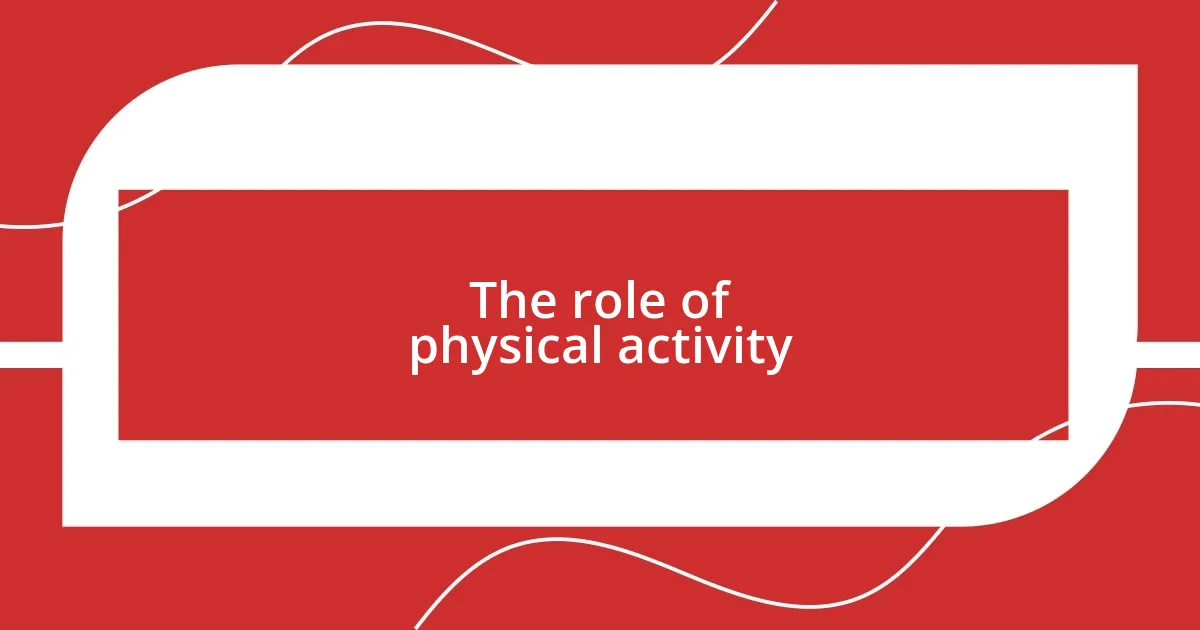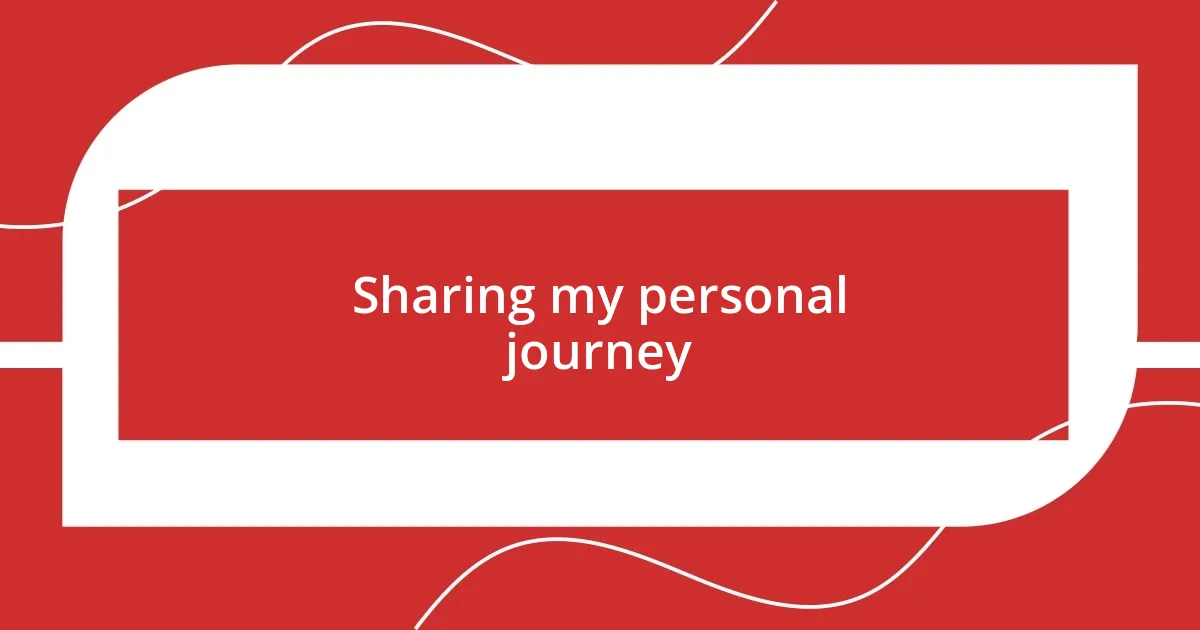Key takeaways:
- Self-doubt is a common experience that can be transformed into motivation by acknowledging and embracing it.
- Physical activity, particularly running, strengthens mental resilience and fosters a positive mindset, helping to combat self-doubt.
- Setting achievable running goals builds confidence and provides a sense of accomplishment, pushing self-doubt away with each success.
- Building a supportive community of fellow runners creates accountability, encouragement, and a shared experience that reinforces self-belief.

Understanding self-doubt
Self-doubt is a sneaky little voice that whispers insidious thoughts, often cropping up when we least expect it. I still remember a day during a particularly tough training session when that voice took hold of me, questioning my abilities. “Why am I even trying?” I asked myself, feeling as if every step forward was a step back into hesitation.
It’s fascinating how pervasive self-doubt can be, showing up in various aspects of our lives and sometimes paralyzing us with fear. I’ve had moments when standing on the starting line, my heart raced not only from excitement but from the nagging thought, “What if I fail?” This duality is something many of us face, and it’s a testament to our own vulnerabilities and aspirations.
Yet, I’ve come to realize that self-doubt is a natural part of the human experience. Have you ever felt it creeping in right when you’re about to take a leap? I found that acknowledging my doubts, instead of fighting them, allowed me to strip away some of their power. Through running, I learned to embrace those moments of uncertainty, transforming them into motivation rather than barriers.

The role of physical activity
Physical activity plays a transformative role in combating self-doubt. I found that every mile I conquered not only improved my physical strength but also fortified my mental resilience. After a challenging week, lacing up my running shoes felt like putting on my armor, ready to tackle not just the pavement but also those lurking doubts.
Engaging in running has a unique way of shifting my mindset. During one long run, I vividly remember feeling overwhelmed by self-criticism. As the rhythm of my feet against the ground matched my heartbeat, each stride became a declaration: I am capable. It’s interesting how the simple act of running can channel negative thoughts into an empowering narrative, enabling me to hold my head a little higher.
In moments of uncertainty, physical activity has served as a reliable ally. I often reflect on races where my confidence surged with every passing mile marker. The endorphins released during those runs lifted my spirits, reminding me that my capabilities stretched beyond what my doubts suggested. Through this experience, I’ve learned the profound lesson that sometimes, to quiet the mind, we need to move our bodies.
| Physical Activity | Self-Doubt |
|---|---|
| Strengthens mental resilience | Undermines confidence |
| Promotes positive self-talk | Fosters negative narratives |
| Boosts mood through endorphins | Can lead to anxiety and hesitation |

Setting achievable running goals
Setting achievable running goals has been a game-changer in my journey against self-doubt. I used to set lofty targets, like running a marathon without considering my current fitness level. But after a couple of disappointing attempts, it hit me—setting smaller, attainable goals not only kept my spirits high but also helped me build momentum. I started with simple objectives, like running a certain distance without stopping or adding a few extra minutes to my daily jog.
Here’s a quick guide that helped me in setting achievable running goals:
- Define Your Why: Understand what drives you to run. Is it fitness, stress relief, or simply enjoyment?
- Break It Down: Instead of aiming to run 10 kilometers right away, start with a goal of running 2 kilometers at first.
- Celebrate Small Wins: Each milestone, whether it’s completing a week of runs or improving your time, deserves recognition.
- Stay Flexible: Life happens. If you miss a workout, don’t be too hard on yourself; just adjust your goals as needed.
- Seek Community Support: Join a running group or find a friend to hold you accountable. Sharing goals can motivate you.
Moving forward, I discovered that as I achieved these smaller goals, my confidence grew exponentially. Each time I laced up my shoes for a run, it was like getting a little pep talk from myself, reminding me that I’m capable of more than I think. I still remember the thrill of running my first 5K after weeks of steady practice—it was such a euphoric rush! It wasn’t just the finish line; it was about proving to myself that I could set a goal and crush it, pushing self-doubt further away with every step.

Building a supportive community
Building a supportive community has been a pivotal part of my running journey. I remember the first time I joined a local running club; I was anxious but surprisingly welcomed. Those early conversations with fellow runners helped me realize that I wasn’t alone in my struggles with self-doubt. Sharing my challenges and triumphs created an environment where we could lift each other up. Have you ever felt that sense of belonging? It’s incredible how camaraderie can motivate you to push past your limits.
I’ve found that running with others not only boosts my performance but also reinforces my belief in myself. One memorable group run took place on a chilly morning, where we paced ourselves as a team through the misty trails. The encouragement I received—from simple shouts of “you’ve got this!” to shared laughter during tough moments—made every mile feel lighter. It’s funny how those little connections can remind you that we all struggle together, yet we can celebrate together, too. Have you ever experienced that shared struggle turning into joy?
Moreover, the accountability that comes from being part of a supportive community has been invaluable. Knowing that someone is waiting for you at the starting line can be a powerful motivator. I recall a particularly cold Tuesday when I thought about skipping my run. However, the thought of letting my friends down pushed me to lace up my shoes and head out. The warmth of their smiles when I arrived transformed what could have been a missed opportunity into a rewarding experience. Isn’t it fascinating how we can inspire one another simply by showing up?

Mindfulness techniques in running
When it comes to mindfulness techniques in running, I’ve found that focusing on my breath can be incredibly grounding. I remember a day when I felt particularly anxious; rather than letting those thoughts take over, I concentrated on the rhythm of my breath as I ran. Inhale for three strides, exhale for two—it became my mantra. This simple act shifted my attention from my worries to my surroundings, allowing me to enjoy the freedom of movement. Have you ever tried using your breath to anchor you in the present moment?
Another technique that has worked wonders for me is body scanning. During a long run, I set aside a minute or two to mentally check in with each part of my body, from my head down to my toes. It’s fascinating how this practice helps me not only notice tension or fatigue but also cultivate gratitude for what my body can do. I vividly recall an afternoon run where I felt tightness in my calves but then remembered the strength I’d built over months of training. This reflection made me appreciate my progress and reminded me that every discomfort is part of the journey. Does this resonate with you—finding appreciation even in the struggle?
Lastly, I’ve embraced the power of visualization. Before races, I often spend a few moments imagining myself crossing the finish line, filled with joy and relief. This mental rehearsal boosts my confidence and helps quiet that pesky inner critic. I once visualized a particularly challenging 10K, picturing each step with clarity. When race day arrived, the moment I actually crossed that finish line, the emotions were overwhelming. My hard work, the community support, and those visualizations came together in a euphoric burst of self-belief. Have you ever experienced the impact of visualization in your own challenges?

Sharing my personal journey
I’ve always seen running as more than just a physical activity; it’s been a journey of self-discovery for me. I can clearly recall my first race—a 5K that felt monumental. The morning was filled with nerves, and I questioned whether I belonged there. As I ran those three point one miles, I realized the thrill of crossing that finish line was not just about speed; it was about silencing the doubts that whispered I wasn’t good enough. Have you ever pushed through a challenging moment only to surprise yourself with what you can achieve?
During my training, I encountered plenty of setbacks that really tested my resolve. There was a point when I was struggling to complete my long runs, often feeling fatigue creep in like an unwelcome specter. But one particular Saturday run stands out. In my mind, I had already convinced myself I wouldn’t make it beyond the halfway mark. However, with each step, I found myself surrounded by the beauty of the trail—the rustling leaves, the distant sound of laughter, and the warmth of the sun shining down. That day, I ran further than I thought possible, and it almost felt like a metaphor for life—sometimes, you just have to keep moving forward, even when self-doubt clouds your path.
Reflecting on my journey, I’ve learned that vulnerability can be a source of strength. Running isn’t just about physical fitness; it opens doors to confront deeper emotions, revealing layers I didn’t know existed. As I shared my experiences with fellow runners, I discovered that many of us carried similar fears and insecurities. It was liberating to be vulnerable and realize that acknowledgment of self-doubt could lead to growth. What about you—have you found strength in vulnerability, even in the pursuit of your goals?















